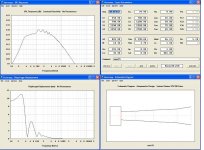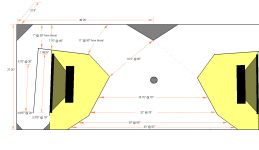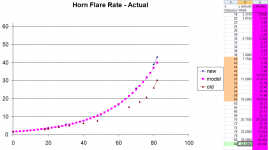Hey gang,
I haven't been too active on here since joining, so I thought I'd share my latest project.
backstory: musical childhood, ex-raver kid, turned DJ/producer, turned nightclub promoter, turned audio engineer, all while living the day life of electronics engineer in medical, then physics, now music software.
I was commissioned by my favorite local club to build the new sub cabinets and after a year or two of reading everything I could get my hands on regarding horn design (which is surprisingly obscure on the internet) and making a modest one that turned out pretty decent, I decided to make one for the big show. My girlfriend and her math professor mom wrote me a simple algorithm to calculate my flare rate, and I picked an arbitrary value for the throat and mouth based on the volume of the internal chamber and the pressure I guessed the speaker might be comfortable with. I'm sure that's absolute sacrilege here, but I just cannot find anything on the web that breaks it down in any simple fashion. Quarter-wave, Leach, even Davids program is beyond me for some reason -though I'll admit to having a bit of a stubborn side when it comes to learning math, something I've never been fluent in. Interesting paradox, no? Also, after two weeks of them waffling over my proposal, I had just 7 days to build and deliver them.
before this gets too long (too late):
It took more hours than I'm willing to admit and more of my heart went into this than probably should have, but I guess that's the nature of great art, right? For three weeks my life (and those unfortunate enough to be stuck with me) became little more than bringing these speakers into the world.
Original order:
(2) Vented Subwoofer Cabinet(s)
featuring:
(2) Selenium 15SWS800 15" pro subwoofers
1,600 watts RMS / 3,200 watts max total power handling
-3dB @ 33.57Hz
Neutrik 4 pole Speakon connections
18mm Birch AC plywood construction
approx. 22"w x 20"d x 34"h
(I used winISD for this one, even though the cabs are trapezoidal)
(1) Dual Folded Horn Subwoofer
featuring:
(2) Eminence Omega Pro-15A 15" Cast Frame Driver
1,600 watts RMS / 3,200 watts max total power handling
Extended response to 35Hz, high SPL capacity, ultra-high efficiency
Neutrik 4 pole Speakon connections
Frame mounted casters for easy transport
18mm Birch AC plywood construction
approx. 78"w x 30"d x 24"h
here's the link to the set: Flickr
A truly heartfelt thanks goes out to: Yamakaze (for enabling production of the entire horn kit), Paulie and Becca (for their skills in master woodworking), Tronathan (for documentation, assistance and beer) and SanDiego (for everything that she does for me, which is everything), without them this would have been an epic fail on many, many levels.
The Aries15
The vented
My first horn
I haven't been too active on here since joining, so I thought I'd share my latest project.
backstory: musical childhood, ex-raver kid, turned DJ/producer, turned nightclub promoter, turned audio engineer, all while living the day life of electronics engineer in medical, then physics, now music software.
I was commissioned by my favorite local club to build the new sub cabinets and after a year or two of reading everything I could get my hands on regarding horn design (which is surprisingly obscure on the internet) and making a modest one that turned out pretty decent, I decided to make one for the big show. My girlfriend and her math professor mom wrote me a simple algorithm to calculate my flare rate, and I picked an arbitrary value for the throat and mouth based on the volume of the internal chamber and the pressure I guessed the speaker might be comfortable with. I'm sure that's absolute sacrilege here, but I just cannot find anything on the web that breaks it down in any simple fashion. Quarter-wave, Leach, even Davids program is beyond me for some reason -though I'll admit to having a bit of a stubborn side when it comes to learning math, something I've never been fluent in. Interesting paradox, no? Also, after two weeks of them waffling over my proposal, I had just 7 days to build and deliver them.
before this gets too long (too late):
It took more hours than I'm willing to admit and more of my heart went into this than probably should have, but I guess that's the nature of great art, right? For three weeks my life (and those unfortunate enough to be stuck with me) became little more than bringing these speakers into the world.
Original order:
(2) Vented Subwoofer Cabinet(s)
featuring:
(2) Selenium 15SWS800 15" pro subwoofers
1,600 watts RMS / 3,200 watts max total power handling
-3dB @ 33.57Hz
Neutrik 4 pole Speakon connections
18mm Birch AC plywood construction
approx. 22"w x 20"d x 34"h
(I used winISD for this one, even though the cabs are trapezoidal)
(1) Dual Folded Horn Subwoofer
featuring:
(2) Eminence Omega Pro-15A 15" Cast Frame Driver
1,600 watts RMS / 3,200 watts max total power handling
Extended response to 35Hz, high SPL capacity, ultra-high efficiency
Neutrik 4 pole Speakon connections
Frame mounted casters for easy transport
18mm Birch AC plywood construction
approx. 78"w x 30"d x 24"h
here's the link to the set: Flickr
A truly heartfelt thanks goes out to: Yamakaze (for enabling production of the entire horn kit), Paulie and Becca (for their skills in master woodworking), Tronathan (for documentation, assistance and beer) and SanDiego (for everything that she does for me, which is everything), without them this would have been an epic fail on many, many levels.
The Aries15
An externally hosted image should be here but it was not working when we last tested it.
An externally hosted image should be here but it was not working when we last tested it.
The vented
An externally hosted image should be here but it was not working when we last tested it.
An externally hosted image should be here but it was not working when we last tested it.
My first horn
An externally hosted image should be here but it was not working when we last tested it.
Well first
Congrats on your baby. Shes a beauty!
Second.
I am baffled. You say you couldn't find literature about horns on the internet yet it abounds with such information. So much that it is well a life time of reading to take it all in. There are ungodly amounts of plans available online.
Got any response graphs? Theoretical or real world?
Congrats on your baby. Shes a beauty!

Second.
I am baffled. You say you couldn't find literature about horns on the internet yet it abounds with such information. So much that it is well a life time of reading to take it all in. There are ungodly amounts of plans available online.
Got any response graphs? Theoretical or real world?
Thanks!
Response curves should be coming tonight. It's running off an Electro-Voice DC 1 processor to a Cerwin Vega CV-2800 amp. I'm going to bring a nice mic (AT 3035) in and hook up an FFT analyzer plug-in I have on my laptop. Then I figure I can EQ the room from there.
I guess with the horn modeling I'm just always looking for that one simple formula that states: "if your 15" sub is has a Qts of .37, make your throat like 2" by 17" by 24" or something". Y'know, someone/thing that really spells it out.
I'm unclear how the throat area is determined. cross sectional? and that in turn confuses measuring the horn width when I get down close to the mouth and I can either stay perpendicular with the back wall, or go at an angle for the longest distance between planes.
As soon as I find out where they hide all the free time I can sit down and devote some time to learning the proper teachings.. hopefully one day I'll hear that ol' click in my head.

Response curves should be coming tonight. It's running off an Electro-Voice DC 1 processor to a Cerwin Vega CV-2800 amp. I'm going to bring a nice mic (AT 3035) in and hook up an FFT analyzer plug-in I have on my laptop. Then I figure I can EQ the room from there.
I guess with the horn modeling I'm just always looking for that one simple formula that states: "if your 15" sub is has a Qts of .37, make your throat like 2" by 17" by 24" or something". Y'know, someone/thing that really spells it out.
I'm unclear how the throat area is determined. cross sectional? and that in turn confuses measuring the horn width when I get down close to the mouth and I can either stay perpendicular with the back wall, or go at an angle for the longest distance between planes.
As soon as I find out where they hide all the free time I can sit down and devote some time to learning the proper teachings.. hopefully one day I'll hear that ol' click in my head.

Neither horn looks anything like a Rog Mogale HD15. The HD15 is a horn/bandpass hybrid - the very compromised horn flare acts more and more like a damped reflex vent near the bottom of the enclosure's effective passband. The defining characteristic of a bandpass horn is a large decoupling chamber between the driver and the horn. Both of the designs showcased in this thread look like quarter-wave horns.
Both of the designs showcased in this thread look like quarter-wave horns.
Yeah, the smaller single unit looks good for about 60 Hz based on quarter wave path length, the double about 45 Hz.
For future reference, the Kappa P15LF2 and the 3015LF are both slightly better for horn loading than the Omega Pro.
post a few dimensions of your 78" baby and I'm sure some enterprising person will post up the hornresp inputs, as well as your simulated output, including displacement.
If nothing else, maybe that'll help you out know where the 'danger zone' is and how much power you should limit to.
If nothing else, maybe that'll help you out know where the 'danger zone' is and how much power you should limit to.
Here's my guesstimate, based on measuring your picture. Since it wasn't exactly 'on axis' my measurements are off, I'm sure.
However, this will get you an approximation.
You need to 48db high pass at 40hz, and limit to 100watts per driver input to prevent exceeding xmax.
I sim'd as a 'half' of the cabinet, and then used 1.0 pi to simulate both halves.
hopefully this is helpful.
However, this will get you an approximation.
You need to 48db high pass at 40hz, and limit to 100watts per driver input to prevent exceeding xmax.
I sim'd as a 'half' of the cabinet, and then used 1.0 pi to simulate both halves.
hopefully this is helpful.
Attachments
Yeah, the smaller single unit looks good for about 60 Hz based on quarter wave path length, the double about 45 Hz.
For future reference, the Kappa P15LF2 and the 3015LF are both slightly better for horn loading than the Omega Pro.
Good to know, thanks.
However, this will get you an approximation.
You need to 48db high pass at 40hz, and limit to 100watts per driver input to prevent exceeding xmax.
Holy balls I hope I didn't do any major damage.
When we tested it, I band-passed it using 12db Linkwitzes programmed from 27Hz to 90Hz. We wired both subs in parallel and hooked them to a Mackie something or other, so there had to be something around 1000W available.
Then we pounded it for a few minutes. Sounded amazing -God, I hope I didn't tear them. I really don't want to have to take it apart..
You are hopefully fine, xlim (when damage is done) is 12mm. However, 30hz@100watts is right at the breaking point.
You should be commended on the smooth response that you achieved with just a little intuition. It is a very nice response.
Now, if you'd trade that omega driver for the 3015lf, with a steep 40hz high pass filter, you can get several db more out of it, and be safe up to 400watts.
If you'll post a couple critical dimensions of your box, someone could get you better than a 'guesstimate.'
again, my commendations to you. I would not have had the courage to make sawdust, with no real idea of the outcome.
You should be commended on the smooth response that you achieved with just a little intuition. It is a very nice response.
Now, if you'd trade that omega driver for the 3015lf, with a steep 40hz high pass filter, you can get several db more out of it, and be safe up to 400watts.
If you'll post a couple critical dimensions of your box, someone could get you better than a 'guesstimate.'
again, my commendations to you. I would not have had the courage to make sawdust, with no real idea of the outcome.
details..
Ok, despite the fact that it only serves to highlight my crude and juvenile techniques, here is a drawing I just made in paint of everything we used to construct. Obviously, this is not to scale. You can see at around 60" from the throat origin I start to waffle on the correct angle to measure distance, but we stayed as close to the flare model as we could. I'm pretty sure the outer cabinet dimensions are correct, and it's all mirrored on the other side.
The purple flare is the model, the blue diamonds peaking out from behind are us, taking measurements every 10" or so, with a few extra stops. We stayed pretty close until those last two.. the old (brown triangles) one was a different configuration we scrapped.
The circle is just a wooden dowel for support.
Anything that anyone could tell me about calculating throat size (area? or volume?) coupling, etc. for use with Hornresp would be immensely appreciated. I can't send you scotch in the mail, but you'd have a friend in Madison anytime you visited.
Thank you jbell for the time you've spent, it's already made the picture much clearer for me.
Ok, despite the fact that it only serves to highlight my crude and juvenile techniques, here is a drawing I just made in paint of everything we used to construct. Obviously, this is not to scale. You can see at around 60" from the throat origin I start to waffle on the correct angle to measure distance, but we stayed as close to the flare model as we could. I'm pretty sure the outer cabinet dimensions are correct, and it's all mirrored on the other side.
The purple flare is the model, the blue diamonds peaking out from behind are us, taking measurements every 10" or so, with a few extra stops. We stayed pretty close until those last two.. the old (brown triangles) one was a different configuration we scrapped.
The circle is just a wooden dowel for support.
Anything that anyone could tell me about calculating throat size (area? or volume?) coupling, etc. for use with Hornresp would be immensely appreciated. I can't send you scotch in the mail, but you'd have a friend in Madison anytime you visited.
Thank you jbell for the time you've spent, it's already made the picture much clearer for me.
Attachments
I finally sat myself down for < an hour and figured out McBean's (thank you!) hornresp program. There's still some stuff I'm not too clear on, but I get the basics. (damn my stubbornness to doing math, it's actually quite simple!)
It isn't anywhere near ideal, but here's the actual curve, based on the construction drawings. I'm not sure how to account for the chambers combining at the mouth though, so I just entered it in as a single side.
would that smooth out if I had three more stacked on top? I should also note there is no throat chamber but the sub fires into the beginning of the flare. Is that really bad form?
Anyway, now I'm itchin' to build something else. correctly.
thanks for the input/advice/guidance!
It isn't anywhere near ideal, but here's the actual curve, based on the construction drawings. I'm not sure how to account for the chambers combining at the mouth though, so I just entered it in as a single side.
An externally hosted image should be here but it was not working when we last tested it.
would that smooth out if I had three more stacked on top? I should also note there is no throat chamber but the sub fires into the beginning of the flare. Is that really bad form?
Anyway, now I'm itchin' to build something else. correctly.
thanks for the input/advice/guidance!
This might help:
Guide to WinISD Pro and Hornresp - Speakerplans.com Forums - Page 1
Best regards Johan
Guide to WinISD Pro and Hornresp - Speakerplans.com Forums - Page 1
Best regards Johan
- Status
- This old topic is closed. If you want to reopen this topic, contact a moderator using the "Report Post" button.
- Home
- Loudspeakers
- Subwoofers
- The Aries15 -a dual horn design original


